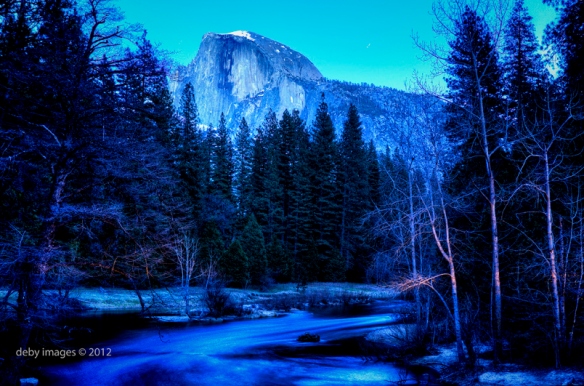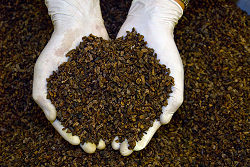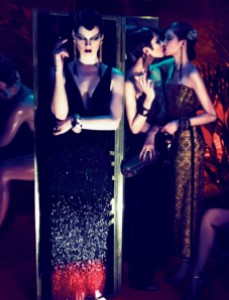We all have a promised land in perfumery, one where we gambol and cavort with our favourite olfactory notes, all combined in such a way that the pleasure, comfort, and joy amounts to a sense of a perfect fit, ease, or even the feeling of being “home.” There are many promised lands, each falling within a different genre, each so difficult to find that it’s as though we’re searching for the Holy Grail. (At this point, I’m convinced that my personal Vanilla Valhalla does not exist.) The difficulty stems from the perfection that is implicitly involved in such a magical creation, the coalescence of personal, subjective factors to form one perfect bouquet like no other.
Tag Archives: Serge Lutens Borneo 1834
Perfume Review – Chanel Les Exclusifs Sycomore: Mighty Vetiver
Close your eyes and imagine you are in the heart of a forest at Yosemite National Park.
Cypress trees and evergreens intermingle and stretch far before you. The dark, dry earth is sprinkled with pine needles, and a wild boar is rooting at the tall grasses at the base of a tree, his endeavors lifting the smell of the earthy, chocolate-y roots into the air. Icicles hang from the branches where, nestled deep within, are purple juniper berries. In the heart of the forest, campfires burn thick logs of pine and cypress, and there is a smell of peppery smoke intermingling with the burning woods. Someone is cooking caramel, and burning it. You huddle deeper into your coat as the hint of frost brings a chill, but you can’t help but take a deeper breath of the vetiver surrounding you.
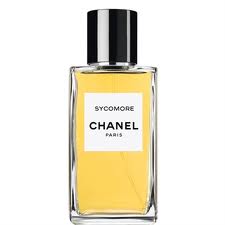 Green and brown, smoky and earthy, with a heart of cypress and wood — that is Chanel‘s Sycomore. It is an incredibly elegant smell, luxurious and leaving a smooth, trail of pure class oozing in its green-brown trail. It is richly masculine, with not a hint of florals, but this is silken masculinity in the most sophisticated, elegant of packages.
Green and brown, smoky and earthy, with a heart of cypress and wood — that is Chanel‘s Sycomore. It is an incredibly elegant smell, luxurious and leaving a smooth, trail of pure class oozing in its green-brown trail. It is richly masculine, with not a hint of florals, but this is silken masculinity in the most sophisticated, elegant of packages.
Sycomore was first introduced to the world in 1930, the creation of Chanel’s very famous, original perfumer, Ernst Beaux. From what I’ve read, it was all violet and tobacco with some support from soft aldehydes and balsamic wood. The original Sycomore vanished in the perfume mists, but it was re-envisioned and re-introduced in 2008 as an eau de toilette and as part of Chanel’s prestige collection called “Les Exclusifs.” It 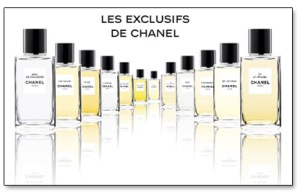 was created by Chanel’s house perfumer, Jacques Polge, along with an equally famous “nose” in the industry, Christopher Sheldrake.
was created by Chanel’s house perfumer, Jacques Polge, along with an equally famous “nose” in the industry, Christopher Sheldrake.
On its website, Chanel describes the new Sycomore as follows:
A rich-wood fragrance with a noble character — like the Sycomore tree that inspired it — created by CHANEL Master Perfumer Jacques Polge in 2008. At the heart of the scent: Vetiver, with an elegant Sandalwood note and dashes of Cypress, Juniper and Pink Pepper, for an earthy, warm and enveloping, yet subtle presence.
I think Chanel’s description nails it, unlike the Fragrantica‘s entry for Sycomore which seems completely incorrect in my opinion. Fragrantica puts Sycomore in the “Woody Floral Musk” category, and lists its notes as “vetiver, sandalwood, aldehydes, tobacco and violet.” I suspect both the categorization and the notes apply only to the 1930s version of Sycomore.
No, Chanel’s notes for Sycomore are the ones to follow and they are clearly listed by the Perfume Shrine as follows:
Vetiver, cypress, juniper, pink pepper, smoke, burning woods.
To get a true understanding of Sycomore, I think it’s important to elaborate a bit on the notes. For example, vetiver which not everyone is familiar with as an ingredient or as a smell, and which is the main part of Sycomore. Chandler Burr, the former New York Times perfume critic, gave this extremely useful explanation to GQ:
In the most basic sense, [vetiver is] a grass native to India that grows in bushes up to 4’x4′. It’s also related to lemon grass, as you can tell when you smell it. The stuff—it’s the grass’s long, thin roots that they distill—is infinitely more interesting though: deep, shadowed, astringent, earthy like newly tilled soil, and balsam-woody. It can be warm like tobacco leaves, it can have a crushed-green leaves freshness, or it can be cool like lemon verbena.
Haiti produces about 80% of the vetiver oil in the world, although sometimes you’ll be putting a bit of Indonesia or Brazil on your arm as well (Haiti’s is more floral, Java’s is smokier). There are folks producing it responsibly, too. When you buy a bottle of Terre d’Hermès, which is loaded with the stuff, you’re supporting around 2,000 Haitian farmers and distillers. […]
Like wine, the scent of vetiver oil improves as it ages: the best of it is made with roots that have been aged somewhere between 18-24 months; the oil costs around $200/kg when it hits the market. American scent maker IFF makes it three ways: with steam (resulting in vetiver essence, which is dryer and lighter), solvent (which produces an absolute and is darker, with the scent of rich dirt), and a new technology called “Molecular Distillation” that uses carbon dioxide to yield a scent that’s extraordinary—strongly grapefruit, fresher, zestier.
The Perfume Shrine says that the vetiver in Sycomore is said to be of the Haitian variety so, under Mr. Burr’s explanation, the more floral kind. I’m not an expert on any of the varieties, so I will take their word for it. All I know is that this vetiver smells exactly as Mr. Burr described: “deep, shadowed, astringent, earthy like newly tilled soil, and balsam-woody.”
Do you know how perfume can sometimes take on a colour aura before your eyes? 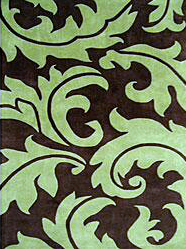 Sycomore opens on me all brown and green. Not khaki but some interwoven panel of dark green and green-brown. It calls to mind green roots and brown earth. Sycomore starts exactly like that, alongside pink peppercorns and an unexpected but definite note of chocolate. It’s almost like chocolate patchouli with vetiver. It’s so confusing that I go over the notes again and, still, I’m at a loss. So, I look up cypress wood which I’m not very familiar with, and that must be the explanation.
Sycomore opens on me all brown and green. Not khaki but some interwoven panel of dark green and green-brown. It calls to mind green roots and brown earth. Sycomore starts exactly like that, alongside pink peppercorns and an unexpected but definite note of chocolate. It’s almost like chocolate patchouli with vetiver. It’s so confusing that I go over the notes again and, still, I’m at a loss. So, I look up cypress wood which I’m not very familiar with, and that must be the explanation.
From my reading, it seems that cypress wood has a pungent, woody, spicy aroma that can also be sometimes resinous, coniferous, or cedar-like. Here, the combination of the cypress wood with the earthiness of the vetiver seems to have transformed the sum total into chocolate patchouli. You can smell each individual note, but you also have that strong overall impression.
It’s so striking that I looked to see if others had felt the same way. On Basenotes, one commentator also thought there was patchouli in Sycomore, though she concludes the cause was the combination of juniper and cypress. The Scent Critic blog and some on MakeupAlley also picked up on the chocolate edge. And finally, Victoria from Bois de Jasmin summed it up in her usual elegant succinctness: “The chocolate richness of the root is accented by the peppery and smoky notes. The composition possesses an alluring dark character, which in sensation alternates between the tannic dryness of red wine and the softly worn polish of aged woods.”
The chocolate and patchouli impression in Sycomore is so strong for the first hour that it evokes Serge Lutens‘ Borneo 1834 in its opening stages. So much so that I’m utterly bewildered by why people compare Chanel’s Coromandel (also from Les Exclusifs) with Borneo 1834, instead of Sycomore. Adding to the similarities between Borneo 1834 and Sycomore is the latter’s strong opening notes of tobacco and smoke. The tobacco note here is faintly bitter, and it is accompanied by a peppery, biting smoky note that is definitely woody.
I wonder about the “burning woods” note listed on many perfume reviews as an element (though not on Chanel’s website), and I keep thinking of guaiac wood. You can read the Glossary for more details but, in a nutshell, guaiac wood has an aroma that is earthy, smoky, tarry, peppery and similar to burning leaves. Tom Ford’s Amber Absolute is also said to have guaiac wood in it, though its official notes are equally vague and merely reference “rich woods” instead of “burning woods.” Both perfumes share a similarly woody, peppery, smoke note, so I have to wonder.
I do smell some sandalwood in Sycomore but, on me, it’s not strong at any point in the perfume’s development. Others have found it, but it’s just a whisper on me. I have to say, I doubt it is real Mysore sandalwood anyway. Anyone who has read Luca Turin and Tania Sanchez’s book, Perfumes: The A-Z Guide, will be struck by their repeated, insistent comments on just how few sandalwood fragrances actually have sandalwood in them at all these days. According to them, true sandalwood from Mysore, India is so scarce and so prohibitively expensive that most perfumers use Australian sandalwood which is an entirely different species of plant and with an entirely different scent. To the extent that Sycomore has sandalwood in it (of any kind), I think it is completely overshadowed and overpowered in the initial stages by the patchouli impression from the cypress and vetiver.
As Sycomore continues to unfurl, there is an impression of burnt caramel, black cocoa powder, incense and dry earth. This is like the black version of Coromandel, without the latter’s vanilla, benzoin and powder heart. The increasingly peppery and smoky nature of the perfume makes me wonder again if they used guaiac wood to fortify any “smoke” accord, not to mention the weak sandalwood. There are also flickering hints of evergreen from the juniper which add a coolness or chill that counters the smoky earthiness. It’s an incredibly sexy, darkly mysterious perfume.
There is a dryness to the rich, earthy smell that really calls to mind dirt — not rich, dank or loamy, but sweetly dry. I realise that non-perfumistas will recoil at the thought of smelling faintly like dirt, but there is really no other way to truly describe the undertones to the very smoked, rich, woody notes. The comparison to dirt also explains Luca Turin’s comments in his five-star review of Sycomore in Perfumes: The A-Z Guide. There, he wrote:
The dream team at Chanel seem to delight in applying superior skills to existing ideas they deem worthy of perfecting: Coromandel was a reorchestration of Lutens’s Borneo 1834…. Sycomore is, in my view, a magisterial gloss on Bertrand Duchaufour’s Timbuktu [for L’Artisan Parfumeur]. The later introduced an Altoids-like idea to perfumery, consisting of a minty-licorice coolness combined with a radiant crackling-wood-fire note. […] Vetiver has both an anisic aspect and a smoky one. Cleverly flank it with Timbuktu’s two companions, add a big slug of sandalwood, and vetiver finds itself in worthy company at last. […] Sycomore [is] … the freshest, most salubrious, yet most satisfyingly rich masculine in years. If putting it on does not make you shiver with pleasure, see a doctor.
I’m surprised that Mr. Turin deems Sycomore one of the few sandalwood fragrance reviews not to warrant his usual comments about how perfumes don’t have real sandalwood in them any more, and I certainly don’t find the same “big slug” as he does, but I agree with the rest of his review. (Minus, his choice of which Chanel perfume to compare to Borneo 1834). I particularly understand his reference to Timbuktu which has often been described as having a dry dirt foundation. Sycomore has both the dirt aspects of Timbuktu and that slightly chilled licorice note underlying the earthiness of the dark patchouli…. er.. vetiver and cypress.
Perhaps it’s all that dry dirt and rich green which make me constantly imagine those old movies that explored the heart of an African forest — everything is slightly dark and smoky, mysterious and 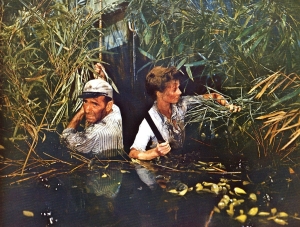 shadowy, all amidst lush greenness and dry red-brown dirt. I keep thinking of Clark Gable with Grace Kelly and Ava Gardner in Mogambo, or Humphrey Bogart and Katherine Hepburn in African Queen. I could see either man wearing Sycomore, and Katherine Hepburn too (though never ever Grace Kelly or Ava Gardner).
shadowy, all amidst lush greenness and dry red-brown dirt. I keep thinking of Clark Gable with Grace Kelly and Ava Gardner in Mogambo, or Humphrey Bogart and Katherine Hepburn in African Queen. I could see either man wearing Sycomore, and Katherine Hepburn too (though never ever Grace Kelly or Ava Gardner).
As time passes, there is even greater depth to the impressions of burnt umber, burnt caramel, resins, saltiness, and earthiness — all under the forest’s canopy of green-brown vetiver and wood. The patchouli impression ceased being dominant a while ago; now it is the turn of the juniper. In general, juniper has an aroma that is fresh, sweet, and like pine trees, with a slightly balsam-like, resinous undertone. Here, they make I feel as though I’m walking through an icy forest at wintertime, my feet crunching on evergreen needles, the chilled smoke of winter in the air, as I walk towards campfires of burning pine logs where someone is cooking with dark chocolate and another person is accidentally burning the caramel. There is still the chocolate note, you see, though it is overshadowed by a more resinous, caramel element. There is also an undertone of anise and licorice.
In its drydown and final hours, all those things vanish, leaving mostly sweet, faintly lemony, grass. It is vaguely reminiscent of the lemongrass that Chandler Burr referenced. The sweetness of the grass may be one reason why a number of people smell marijuana or cannabis a few hours into Sycomore. I do not, but the occasional “ganja” comment is something worth noting if you’re tempted to try Sycomore. What I do smell, in addition to the sweet grass, is a sort of creaminess that I think comes from the sandalwood. As always, however, it is faint; even more of a shadow now than before.
There are two things which confused me about Sycomore. One, which I’ve already mentioned, is that it is Coromandel which is compared to Borneo 1834, when I think it should be this Polge and Sheldrake collaboration instead. (At least, for the opening hour. I don’t think Coromandel is remotely like Borneo 1834.) The second is a far more important issue: Chanel’s gender classification for this scent. Chanel has labeled Sycomore as a woman’s perfume and, to me, that is akin to saying M&Ms are only for women. It makes absolutely no sense at all.
Not only is Sycomore unisex, not only is it the furthest thing possible from “girly,” and not only do men adore this, but it is — I would argue — actually a masculine scent first and foremost. It may be a somewhat feminine masculine fragrance, but it is a masculine fragrance at its heart. In fact, women who have not explored niche scents and who are used to the more traditional, conventional or mass-market feminine fragrances — whether of the floral, “girly,” clean, sugary or gourmand variety — may find Sycomore to be overwhelmingly masculine and an utter shock if purchased blind. This is no Marc Jacob Lola, Guerlain Shalimar or Dior J’adore.
No, Sycomore has consistently been compared to men’s colognes. In fact, commentators on both Basenotes and Fragrantica find it to be an exact duplicate of Lalique‘s L’Encre Noire for Men (2006). A few people even bring up Hermès‘ men’s cologne, Terre d’Hermès — though most people on Basenotes find that much more citrus based and without anything close to the same degree of vetiver in it (no matter what Chandler Burr may think). I agree with that. I’ve got Terre d’Hermès and like it. But, like many on Basenotes, I find them to be very different perfumes and don’t think Terre d’Hermès is a predominantly vetiver scent. As a point of interest, in a Basenotes thread asking for people’s preference as between Sycomore and Terre d’Hermes, a monumental majority chose Sycomore as the better, more elegant, and truer vetiver fragrance.
All in all, Sycomore is an incredibly lovely fragrance and as smooth as silk. It is magnificently blended, such that everything folds into one rich layer upon another. There is a paradoxical coolness to its warmth, but it is never a chilly or aloof scent. It has too much earthiness in its beating heart, radiating its fire with every thump, thump, thump. It is never cloying, and there is not a single, synthetic, cheap note anywhere to be seen. It is truly as masterful and brilliant as so many thing. It is also a very approachable fragrance; it is not one of those edgy, discordant scents that can be worn only infrequently and are to be admired mostly on an intellectual basis as works of olfactory art. I can see men wearing this almost daily and some women frequently.
And, yet, it is not a fragrance for me. For the longest time, I could not pinpoint why. I like vetiver, I wear men’s cologne, and I like smoke and resinous scents. I find it an extremely elegant perfume and, really, it should push all my buttons. In fact, its opening led me to say “Wow” and I couldn’t stop sniffing my wrists for the first ten minutes. But, at the end of the day, it was simply too much vetiver and its dryness could well be described as bone-dry. Sahara dry. For my personal tastes, Sycomore simply veers too much into the masculine without any real sweetness to accompany it.
Nonetheless, if you are a fan of vetiver, woody and/or dry scents, I highly encourage you to test out Sycomore. If you’re not a fan of either of those three categories, then you may like the sweeter, softer Coromandel. (It is my favorite of the 3 Exclusifs that I’ve tried thus far). But if you’re not a fan of patchouli, benzoin or frankincense, then I fear you should skip that one too.
Have you tried Sycomore? If so, was it love at first sniff or simply not your cup of tea?
Details:
Sillage & Longevity: The sillage and longevity of Sycomore is impressive, particularly given that most of the Exclusifs line (with the exception of Coromandel) are said to be thin, sheer, and of short duration. On me, Sycomore had good projection for the first 3 hours, and only became close to the skin after 5 hours. As for longevity, it was above-average for my perfume-consuming skin. I could still smell faint traces of it after 9 hours. On others, I’ve read reports of it lasting almost an entire day.
Cost & Availability: Sycomore only comes in Eau de Toilette concentration and costs $130 for a 2.5 oz/75 ml bottle or $230 for a 6.8 oz/200 ml bottle. The Exclusifs line is available only in Chanel stores or on their website. I have read numerous comments from people who have tried it at Selfridges in the UK, but did I not see a single Les Exclusifs fragrance on the Selfridges website. Nor have I found it on any U.S. department store websites. It’s not on Lucky Scent either. It is, however, available on Surrender to Chance which is where I obtained my sample. Prices for the smallest vial (1 ml) start at $3.
Perfume Review- Serge Lutens Borneo 1834
Serge Lutens wants to take you on journey to the heart of 19th century Borneo, an island on the equator, north of Java, and which now consists of Indonesia, Malaysia and Brunei. He wants to take you on the Dutch trading ships with their bales of raw silks and cocoa as they traversed the exotic seas on their way to the shops of Europe. And he does it via Borneo 1834, a perfume created with Lutens’ usual cohort in olfactory adventures, the famous nose Christopher Sheldrake. It was released in 2005 and, until 2010, was exclusive to Lutens’ Paris salon as part of the “non-export” line. At the moment, however, it is available worldwide via the Lutens website.
Fragrantica classifies Borneo 1834 as an “oriental woody” and lists its notes as:
patchouli, white flowers, cardamom, galbanum, french labdanum and cacao.
Bois de Jasmin, however, also adds in camphor and cannabis resin. The latter led me to some Google searches, with extremely amusing results, on what constitutes the exact smell of cannabis when in resin form. (My conclusion is that some people lead very… interesting… lives.) 
On his website. Lutens explains his choice of name and the theory behind the scent:
Why did I pick 1834? That was the year Parisians discovered patchouli. In those days, it came wrapped in silk.
Imagine a woman of that time wearing a patchouli fragrance: she awaits her carriage, draped in her sable stole.
 The famous perfume expert and critic, Luca Turin, provides even more explanation in his book, Perfumes: The A-Z Guide. In his four-star review of the fragrance, he says:
The famous perfume expert and critic, Luca Turin, provides even more explanation in his book, Perfumes: The A-Z Guide. In his four-star review of the fragrance, he says:
Apparently Lutens has determined that the first olfactory point of contact between Europe and the Far East took place there and then, in the form of the patchouli leaves used to wrap bales of silk. The patchouli was intended to keep moths away from the precious fabric (insects hate camphoraceous smells), but when the silk reached Western shores, elegant ladies wanted more of the smell. In other words, patchouli’s career in perfumery is a rise from bug repellent to luxury goods, a trajectory meteorically traced in the opposite direction by many contemporary fragrances. As often happens with Lutens-Sheldrake creations, the first sniff comes as a complete shock: the overwhelming impression is one of dark brown powder. Seconds later one realizes that this nameless dust is made of two components, patchouli and chocolate, skillfully juxtaposed (how?) so that neither the earthiness of patchouli nor the familiarity of chocolate prevails. Borneo 1834 is like Angel in reverse: instead of jumping out at you, it sucks you into its shadowy space. All the materials used are firmly rooted in the “orientalist” (aka hippie) style, yet the size, grace, and complexity of the overall structure make it the direct descendant of orientals proper like Emeraude and Shalimar. [Emphasis added for the names.]
The opening blast of Borneo 1834 on my skin is glorious. I absolutely love it. There is wonderfully resinous, boozy, sweet patchouli with bitter chocolate. The latter is more like the small, dark, cocoa nibs that you find in baking. There is a faint hint of camphor, but it’s light and plays off well with the smokiness of the patchouli and labdanum. It’s not the sort of smoke that you find in incense but, rather, a sweeter, much nuttier smoke accord. It makes me think of siam sesin, only amplified and combined with patchouli and cocoa. (You can read more about siam resin, along with labdanum, galbanum and some of the other notes in Borneo 1834 in my Glossary.) The patchouli has a great earthiness, almost like rich, black earth — moist, loamy and heavy. There is a faint hint of a musky, animalic note, too, almost like the sort of body funk that you would get from civet.
I don’t smell cardamom or the white flowers to any noteworthy extent. There is a floral note there, faintly peeking its head over the mighty patchouli, but I don’t think “white flowers” would really come to mind. If there is a floral note, I’d think of a pale rose more than white flowers, but it doesn’t really matter as the note is so faint as to be barely noticeable.
As for the notes given by Bois de Jasmin, I have never smelled a fresh, growing cannabis plant, let alone cannabis resin, so I set off to do some research. Google informs me that the former smells like slightly herbal, sweet, cut grass, while the latter can supposedly smell of anything from skunks to motor oil. I don’t smell fresh, sweet grass in Borneo 1834, and definitely nothing even remotely resembling skunks. I suppose one could say that there is a faint scent of car oil, but I think that the tarry, black note is more typical of a dirty, black patchouli or labdanum. Overall, the scent is dry in its sweetness, not cloying or synthetically sharp.
Thirty minutes in, the dark cocoa is on equal footing with the patchouli, and the light camphor note has vanished. There are times when the final result almost smells a bit like mocha coffee. It is too rich a smell to be considered “cozy,” especially as that is a word which I associate with softer scents that wrap themselves around you like cashmere or that make you want to snuggle under a blanket. Borneo 1834 is too dark for that. It is also too dry to be an edible gourmand scent, but it has some mystery and layers, especially in its opening. I truly adore those opening notes of patchouli which make me think, “this is what patchouli should smell like more often!”
I’m much less thrilled with the middle stages and the dry-down. Two hours in, the musk and animalic notes start to become much more pronounced. It is at this stage that the sillage lessens a little, though it is still somewhat noticeable. (Three hours in, the perfume becomes close to the skin, though there is still great longevity.) The animalic notes become more and more prominent with every hour, and the final dry-down stage is almost entirely earthy, slightly intimate body funk.
It’s hard to explain the scent here. It’s not intimate like someone’s private parts, it’s also not exactly musky, and it’s most definitely not like ripe, extreme, unwashed body odor. It’s sort of a mild variation of the two, a “skank” note like that from a very warm, faintly sweaty, slightly sweet, almost musky body after a long session at the gym. Perhaps, musk and sweet “dried sweat” may encapsulate some of it, but only a portion of it. Either way, there is a linearity and earthy singularity in the middle and final stages which is fine, if you like animalic notes. I don’t. Which is why I much preferred that absolutely lovely opening with its boozy notes evocative of siam resin, its luscious patchouli and its dry cocoa.
That dark, black, and faintly bitter, cocoa accord is just one of the things that separates Borneo 1834 from Christopher Sheldrake’s other patchouli creation: Coromandel (for Chanel‘s Les Exclusif line). Created with Jacques Polge, both perfumes share chocolate and patchouli notes, which is probably why they are so frequently discussed in the same breath. To me, however, Coromandel is an extremely different scent. In fact, I’d consider them to be like night and day. I found Coromandel to be all burning smoke, white cocoa and powdery vanilla, resembling a chai latte at times. The strong incense and frankincense notes dominated the sweet patchouli; it was a frankincense and incense perfume first and foremost. At its heart though, Coromandel is a cozy scent with powdered vanilla and tonka; it is light and somewhat multi-faceted. Borneo 1834, in contrast, is a dark powerhouse of patchouli, bitter cocoa dust and earthiness, and it’s not extremely complex. In fact, I’d say that it only has two stages, each of which is quite direct: patchouli chocolate with some camphor, resin and smoke; and earthy, animalic notes.
Freddie from Smelly Thoughts, a great perfume blog, loved the perfume throughout all its stages and didn’t seem to note any animalic body funk. His review is useful, especially as it compares Borneo 1834 to Thierry Mugler‘s infamous Angel:
So patchouli + chocolate = Angel? Not quite. The patchouli here is lavishly sleek, whilst being familiar in its dank, deep scent – it remains tame and completely in control. The sweetness in Borneo, unlike the Mugler, is also in complete control, richer – more exotic, with a delicate camphor laying over the top – adding an almost medicinal astringency to the patchouli and cocoa. The camphor is far from the intensity of Tuberuese Criminelle (for example), and instead has the sheer, sharp aspect that some great ouds have. It adds an age and a chilling subtlety to the foggy atmosphere.
I get a very subtle tobacco, as well as a liquorice note – in the same, but more toned down, style of Parfumerie Generale’s Aomassai. All intermingled with the cocoa and bitter patchouli, Borneo 1834 is dark and perplexing whilst being light and delicate on the skin.
The fragrance remains relatively linear, with a wonderful resinous base acting like a dark, sticky veil. The resins give off that breathy/slightly sweaty feel that they sometimes do (I normally get this with myrrh), I’d almost have thought there was the tiniest bit of cumin in here, but the fragrance isn’t spicy at all.
I think Freddie’s reference to cumin indicates that he may have smelled some animalic funk too, but obviously, it was in no way as extreme on him as it was on me during those final hours. All in all, Borneo 1834 lasted about 9 hours on me, with the animalic funk being a large part of the last (low sillage) 6.5 hours (and all of the final 3 hours). It is the main reason why I didn’t love the fragrance, though it’s an absolutely gorgeous scent in its opening notes.
Borneo 1934 is a scent that is definitely well-suited to winter and, if you love patchouli, well worth a sample sniff. If you try it, let me know what you think. I’m particularly curious to know if you have a similar experience as I did during the final hours.
Details:
Cost & Availability: You can find Borneo 1834 on the Serge Lutens website. In the famous bell-jar shape, it costs $290 for 2.5 fl oz/75 ml. However, in the smaller size and  regular bottle, it costs $140 for 1.7 fl oz/50 ml. In general, Serge Lutens is usually available at fine retailers like Barney’s, Lucky Scent and a few other online sites. Lucky Scent carries the 1.7 oz/50 ml bottle for $140 but, oddly enough, I’ve seen it sold on Amazon for $125 via Beauty Encounter. You can only do a search online to see if it is available at a discount from discount perfume retailers. Sample vials to test it out can be bought at Surrender to Chance (but not Lucky Scent) starting at $3.99. Surrender to Chance also has a special Lutens sample pack of 3 non-export perfumes which includes Borneo 1834 and which starts at $11.50 for the smallest sized vials.
regular bottle, it costs $140 for 1.7 fl oz/50 ml. In general, Serge Lutens is usually available at fine retailers like Barney’s, Lucky Scent and a few other online sites. Lucky Scent carries the 1.7 oz/50 ml bottle for $140 but, oddly enough, I’ve seen it sold on Amazon for $125 via Beauty Encounter. You can only do a search online to see if it is available at a discount from discount perfume retailers. Sample vials to test it out can be bought at Surrender to Chance (but not Lucky Scent) starting at $3.99. Surrender to Chance also has a special Lutens sample pack of 3 non-export perfumes which includes Borneo 1834 and which starts at $11.50 for the smallest sized vials.
Perfume Review: Chanel Coromandel – Frankincense & Opium Dens
Were the Three Wise Men or Magi visiting Bethlehem today, Chanel’s Coromandel is a gift that they might have enjoyed wearing (even if it isn’t a suitable gift for a child in a manger).
So, too, would those “Chasing the Dragon” in Imperial China’s opium dens, their limbs sinuous and contorted by their dark obsessions. It is, without question, a perfume of the mysterious, ancient East.
Coromandel is said to be an homage to Coco Chanel’s beloved lacquered, wooden Chinese folding screens and was introduced to the world in 2007 as part of Chanel’s six-line collection called “Les Exclusifs.” It was created by Chanel’s house perfumer, Jacques Polge, along with an equally famous “nose” in the industry, Christopher Sheldrake. According to Chanel’s own description on their website, “the elaborate scent unfolds in undulating detail, starting with an amber vibrato, followed by dry notes of Frankincense and Benzoin, then, soulful woody notes that add elegance and depth to the sensuous accord’s striking trail.”
The notes, according to a reviewer (“Zut”) on Basenotes, are as follows:
Top: citruses, bitter orange, neroli
Heart: jasmine, rose, patchouli, orris
Base: incense, olibanum [also known as Frankincense], benzoin, woodsy notes, musk, Tahitian vanilla
Coromandel is a perfume that reminds me that life would be much easier if I had significantly less expensive tastes. It’s not a perfume I adore with a searing passion, but it is a perfume that I definitely like a lot. A LOT. (Far too much for my wallet’s good health, actually. I suspect I will try to buy a full bottle of this.)
Coromandel opens with a burst of zesty citrus, powder and vanilla. Unlike one reviewer on Basenotes, I don’t smell bitter orange, only basic citrus. Two to four minutes in, the citrus is gone completely, leaving only vanilla musk, patchouli and a hint of almond. Exactly 10 minutes from the time I put in on, the vanilla musk turns darkly and intensely peppery. It is a sharp and dramatic change in such a brief period of time. As the frankincense and/or patchouli rise to the forefront, the perfume changes again. There are wisps of a milk chocolate smell that start to emerge.
I must be honest, and I need to say this from the onset, I truly cannot tell if it is the patchouli or frankincense that is more at play with Coromandel. Everyone talks about how this is such a patchouli monster, and it most definitely has patchouli at its heart. But I truly think that this is more of a frankincense monster than a patchouli one. While there are all kinds of dirty, dark patchouli out there, they all generally seem to have (on me) a warmer, softer edge than what I am picking up in Coromandel. Coromandel’s patchouli (if that is what I’m smelling for the most part) is different than the dirty patchouli that is in Hermès’ Elixir de Merveilles, to mention a patchouli perfume that I just recently reviewed. On me, Coromandel has a much more smoky, piercing, sharp, almost screeching (but in a good way), burning incense note, one that I associate with frankincense far more than with patchouli.
Regardless of whether it’s the frankincense or the patchouli that truly dominates here, the overall whole in the early stages is that of a very milky oriental. I have definite flashbacks to a milky Chai, with a touch of cinnamon, a good dollop of white cocoa, sugar, amber and lots of powdered vanilla. It’s an inescapable image for the first 40 minutes of the perfume’s development on my arm. It’s also a very comforting scent that brings to mind curling up under a thick, beige cashmere blanket, next to a roaring fire, as you sip that aforementioned Chai tea.
It is around this time that Coromandel’s milky vanilla spice has been joined by rose, violet and a faint hint of jasmine. It’s not the full-blown, blowsy, overly-sweet rose of YSL’s Paris, but a softer rose that is moderated by the violet note. The rose-violet-vanilla scent reminds me strongly of the old-fashioned, expensive lipsticks I used to buy in Paris, and of Chanel’s lipsticks themselves. The cause is the orris root mentioned amongst the ingredients. Orris root is the root of the iris flower ,and is often used in perfume or makeup as a fixative or base. It has a richly floral, heavy scent, often evocative of violets. And I can definitely smell it here.
There is supposed to be a strong thread of amber floating throughout Coromandel, but I find it overwhelmed by the frankincense. It’s amazingly strong, and I’m glad for it. I absolutely adore it, more than the increasingly common amber accord that is found in so many fragrances today.
Strangely enough, the perfume is getting more intense on my arm. Two and a half hours in, I wrote in my notes: “how is this just getting stronger???!?!?!!” It’s quite a feat, but it has put me in Coromandel’s thrall. As the peppery smoke increases along with the incense, I get flickering images of an old, quiet, dark Russian Orthodox church where black-robed, black-bearded priests walk through the hushed aisles, swinging those gleaming silver canisters back and forth as the smoke drifts all around them.
With every passing moment, however, the image which grows strongest in my mind is that of a lush, rich, red-silk lined opium den in Imperial China. (Or Johnny Depp “chasing the dragon” in a London opium den in the film, “From Hell.”) Coromandel is one of the very few things I’ve smelled that strongly calls to mind YSL’s Opium, in its true, vintage, 1970s, un-reformulated parfum glory. That almost sexually decadent smokiness is redolent of dark rooms reeking of vice and sinuous bodies, their limbs twisted and contorted in the pursuit of their madness.
True, unvarnished, untainted Opium is my absolute favorite perfume in the world. (We shall not speak of the travesty that it is in its current incarnation. We cannot. It is simply too painful.) True Opium was an ode to licentious abandon and unbridled passion.
It was pure, oozing sex, writhing under a full moon, baying in passion as your darkest side emerged and you lost all control. Opium captured my soul in the 1970s as a young child and it never let go. For true Opium, I would go to hell and back.
Coromandel is not Opium. It is too powdery, especially in its dry-down. It lacks Opium’s rawness, its power and its dark, unctuous slither. But it tries to be Opium’s soft, refined, sweet, baby sister in some ways. The incense and smoke that almost burns your nose is very evocative of Opium’s dark side. But it is incense and smoke wrapped up in powder, pearls, lace and cashmere, not in red-silk tuxedo held half-open and revealingly with one, long, taloned red-laquered finger nail.
No, that is not Coromandel. In its middle and final stages, Coromandel may be better suited to Tolstoy’s tragic heroine, Anna Karenina, in the novel by the same name. Try to imagine Kiera Knightley’s “Anna Karenina” in an old, dark Russian Orthodox Church and you may get closer to the image that Coromandel evokes when I wear it. 
A few final things: this is not necessarily a perfume that only a woman can wear. I think its smokiness and incense-y character makes it very accessible to men, as do the “woody” notes that so many seem to smell so strongly (but not me). I have read some female  commentators say that it’s actually “too masculine.” I find that simply baffling. This is a scent everyone can wear if they should so choose. In fact, one of my closest male friends is bewitched by it. He is a man who adores YSL’s controversial, roaring, polarising, definitely masculine M7, too, so it’s not as though he leans towards “feminine” scents. If you’re a man and you’re intrigued by Coromandel, I think you should give it a shot.
commentators say that it’s actually “too masculine.” I find that simply baffling. This is a scent everyone can wear if they should so choose. In fact, one of my closest male friends is bewitched by it. He is a man who adores YSL’s controversial, roaring, polarising, definitely masculine M7, too, so it’s not as though he leans towards “feminine” scents. If you’re a man and you’re intrigued by Coromandel, I think you should give it a shot.  Even if you’re someone who normally fears powdery or powdery vanilla scents, the degree of smokiness and spice may be enough to offset any “old lady” concerns that you might have.
Even if you’re someone who normally fears powdery or powdery vanilla scents, the degree of smokiness and spice may be enough to offset any “old lady” concerns that you might have.
If you simply can’t get passed the thought of powdered vanilla, then you may want to try Serge Lutens’ Borneo 1834, also created by Christopher Sheldrake. I’ve never tried it but, from reviews like the one I’ve linked to there, it seems that there are a number of similarities. Both share what appears to be Sheldrake’s signature: a bold, sweet, spicy oriental that almost seems like a gourmand perfume at times but which is built around a solid base of patchouli. Borneo, however, is said to have a greater darkness with more bitter dark chocolate (in lieu of the white cocoa) and much earthier, heavier patchouli. (By the way, there isn’t any chocolate actually in either perfume. They simply evoke the scent on occasion.) If Coromandel is not for you, then perhaps Borneo 1834 will be. I hope you will let me know what you think if you try either one.
______________________________


